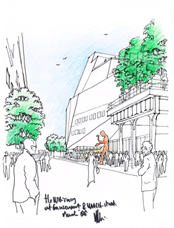
Drawing of the proposed Downtown Whitney
Courtesy of Renzo Piano Building Workshop in collaboration with Cooper, Robertson & Partners
Is Jonathan Borofsky‘s “Hammering Man” (in orange, above) the perfect accessory for any museum entrance?

Entrance to Seattle Art Museum
By Guest Blogger Martin Filler
Renzo Piano breaks out of the box with his latest Whitney encore, but will it break the museum’s bank account too?
There was the unmistakable air of catch-up ball at the press briefing-cum-buffet hosted in the Whitney Museum’s boardroom by director Adam Weinberg on Thursday afternoon, more than a month after Nicolai Ouroussoff‘s NY Times review of Piano’s plans for the museum’s projected offshoot in Manhattan’s Meatpacking District on the Lower West Side.
The lengthy advance access accorded by the Whitney to the country’s most influential newspaper was perhaps understandable, but also a foolish mistake. It has caused considerable resentment among journalists offended by the unsavory favoritism of a “first exclusive” newsbreak more befitting the showbiz values of Vanity Fair than a public cultural institution. Given the repeated press beatings the Whitney has endured for decades, you’d think by now it’d be hipper to the predictable fallout from such gratuitous slights.
Apparently someone decided that sharing the Whitney’s expansion plans with other writers wasn’t such a bad idea after all. But the merciless pecking order of media relations in New York added another subtext to Thursday’s event, which was attended by some 20 architectural press B-Listers, including myself. Predictably absent were the three most powerful critics–Ouroussoff, The Wall Street Journal‘s Ada Louise Huxtable, and the New Yorker‘s Paul Goldberger–who seldom descend among their lowlier colleagues because of the favored treatment they command. Too bad for them, as there are always nuggets of revealing information to be mined at these things, despite the canned info and gimlet-eyed competitors.
The good news is that Piano’s latest scheme—his third, after proposals for the museum’s Upper East Side site were shot down by self-serving community opponents—is not only a vast improvement over its wan precursors, but also among the architect’s strongest outings of late. This six-story structure, for a full-block plot at West and Gansevoort Streets, marks a noteworthy departure from his customary museum formula of the enlongated box, a parti essentially unchanged since Piano and Richard Rogers‘ Pompidou Center opened more than 30 years ago.
The Downtown Whitney might be described as a cross between Frank Gehry‘s InterActiveCorp Building of 2007, a half-mile to the north, and Marcel Breuer‘s original Whitney of 1966. Combining the faceted, upward-tapering massing of the former with the monolithic hauteur and monumental trapezoidal windows of the latter, the overall effect is somewhat conservative, but that’s Piano’s appeal for many. (The cladding has yet to be determined, though the architect is leaning toward stone.)
Happily, Piano cannot overcome an incorrigible candor uncommon among architects, though he is likewise incapable of outright indiscretion, thanks to his ingrained Italian respect for la bella figura. At Weinberg’s lunch, the architect disclaimed intentional references to Breuer’s Whitney, but then let slip that the new structure’s massive elevators were “one of many ideas we stole from this building.” And a few minutes after his expected nod toward the High Line, which adjoins the expansion site, he more accurately termed this infrastructural fetish object “nothing special, but it’s there.” Piano’s diffident charm and stealthy irony allow him to get away with comments that could derail a lesser career.
The quality of this design is unassailable. Doubtful is the client’s ability to raise the $680 million (about two-thirds of which is building costs) needed to bring this ambitious vision to completion. Didn’t the Whitney, which has launched more satellites than Cape Canaveral, swear off scatter-site expansion? When one journalist questioned the wisdom of dividing the museum’s physical plant, Weinberg optimistically cited the success of London’s multi-venue Tate. As Piano might add, “Magari!“—“It should only be so!”
The biggest obstacle will be the $435-million construction tab (certain to rise before the projected completion in early 2013)—a huge amount of money in a faltering economy for donors who (with few exceptions beyond outgoing Whitney board chairman Leonard Lauder) don’t wield the financial clout of MoMA’s trustees, themselves stretched to the limit by an equivalent capital campaign in better times.
After the lunch, I walked down one of the greatest staircases in all of modern architecture, and felt thankful for Lauder’s crafty maneuver in making his recent $131-million gift to the museum conditional on the museum’s retaining the Breuer landmark. If yet another Whitney aggrandizement bites the dust, he’s guaranteed a pretty nice fallback position.
CultureGrrl adds: In other NYC Renzo Piano news—Yesterday, two stuntmen (one professional, one amateur) perilously but successfully climbed the horizontal rods adorning the exterior of the architect’s New York Times building—a 52-story jungle gym that may now require vigilant monitoring.
